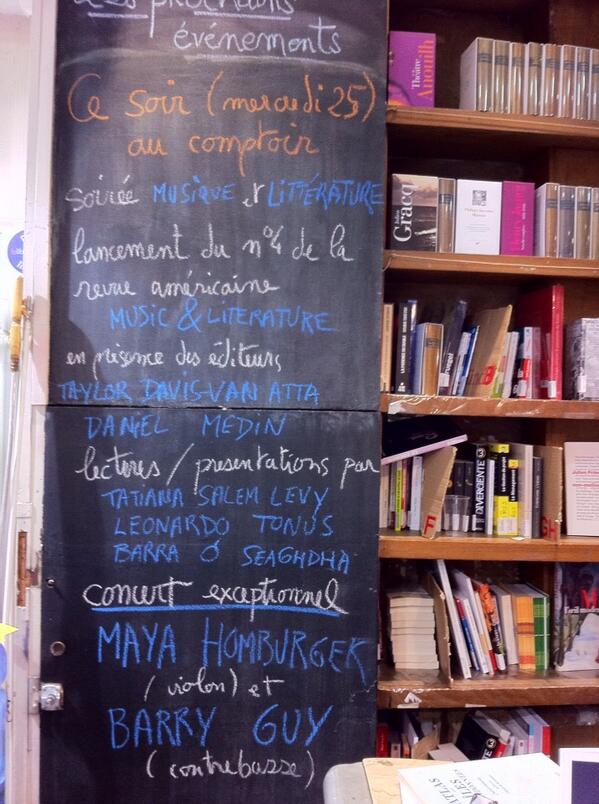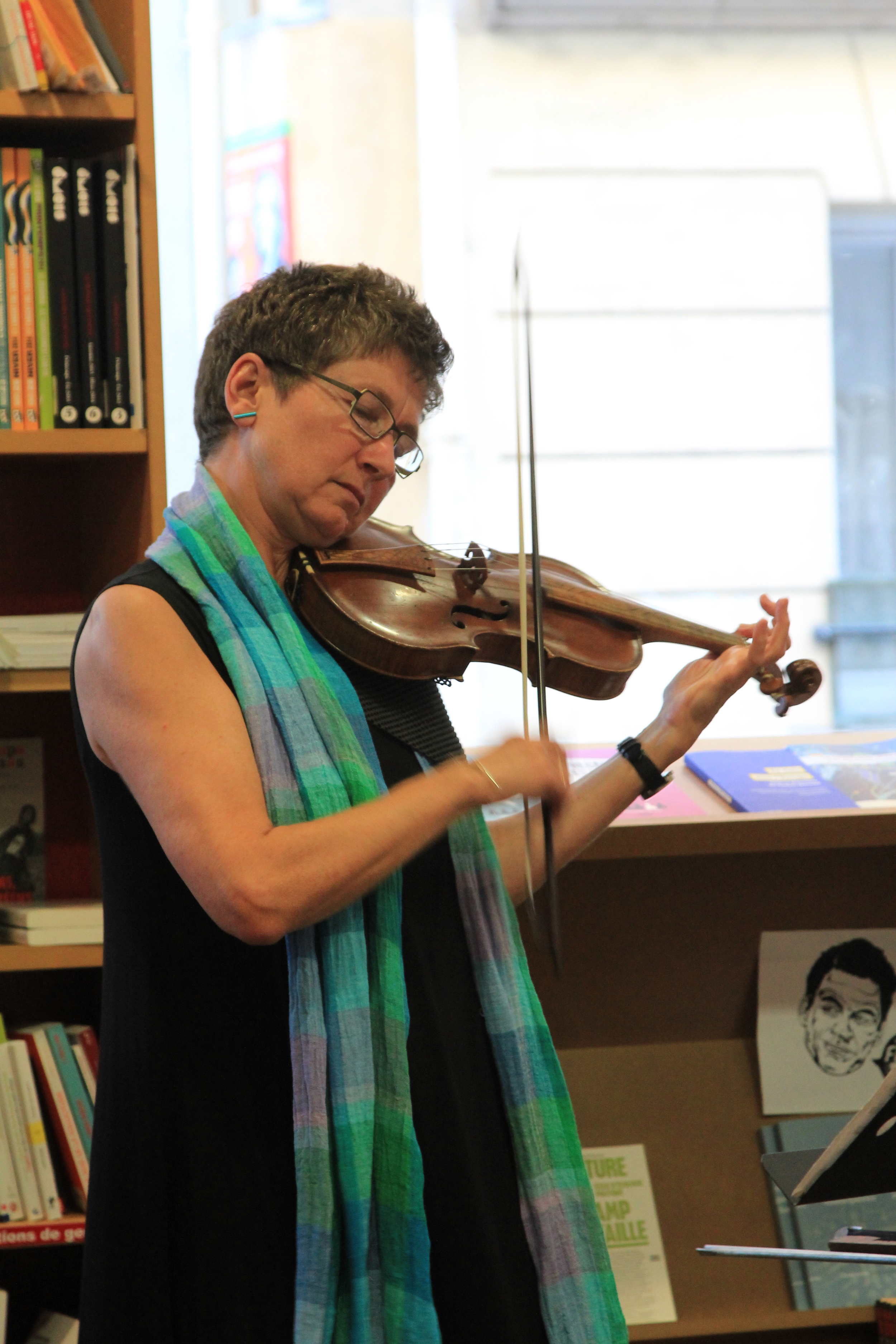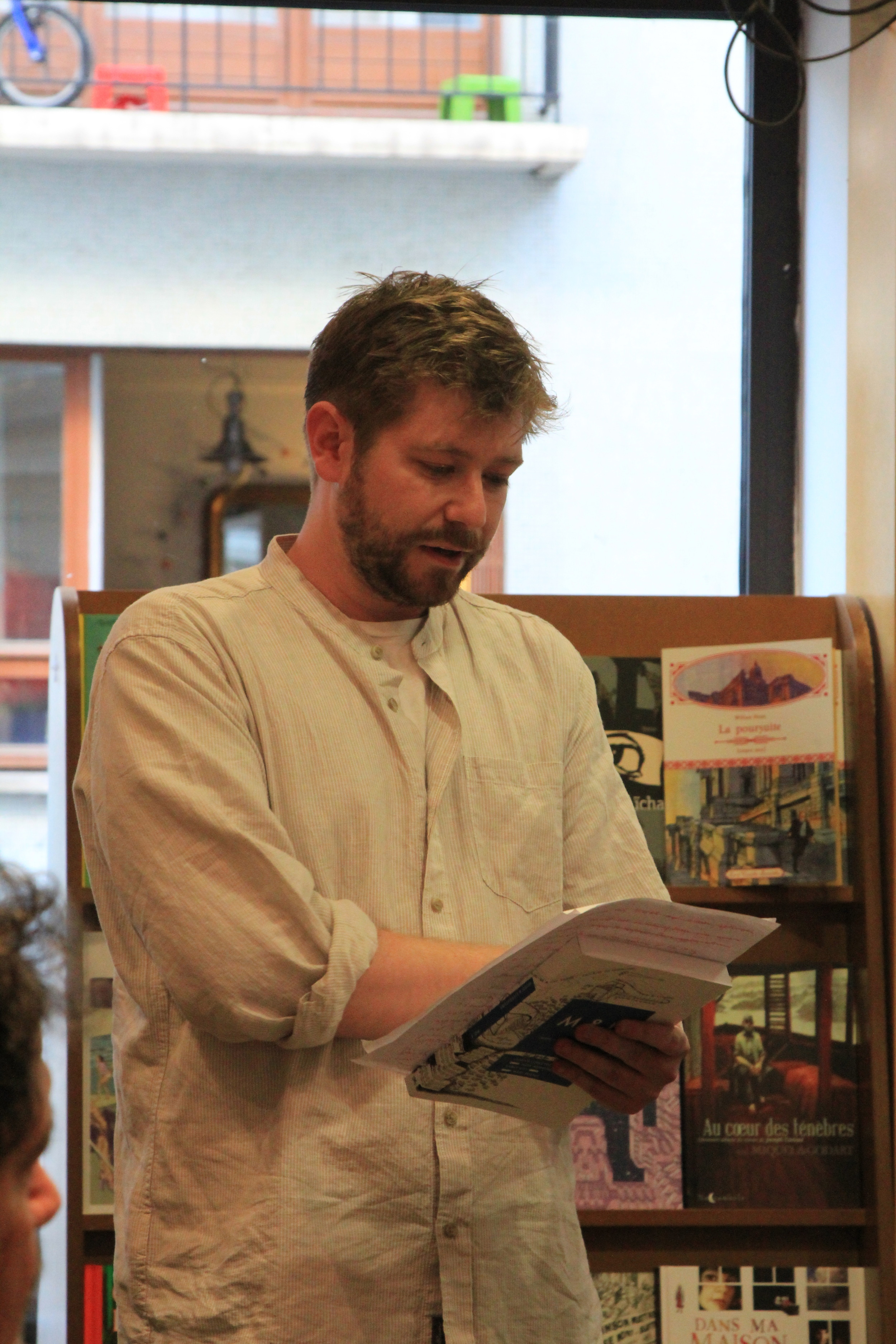The paris Launches of Music & Literature No. 4:
Le comptoir des mots / 25 June 2014
Goethe-Institut / 26 June 2014
“Do you have a sense of an underlying commonality among the artists or writers you are highlighting?” Michael Barron asked Music & Literature’s editors, Taylor Davis-Van Atta and Daniel Medin, in a recent interview for New Directions. The question was particularly fitting for M&L no. 4, since what draws Brazilian novelist Clarice Lispector, Swiss violinist Maya Homburger, British composer/double bassist Barry Guy, and American poet Mary Ruefle is not obvious at first glance. In the print magazine, each artist is contained within their own section, but in a live event, their voices hang together in the air, something of one’s resonating with something of another’s—hesitantly, curiously, sometimes touchingly. Many attendees at the two recent Paris launches came for Lispector and ended up equally loving Homburger and Guy; others came for Homburger and Guy and walked away also adoring Ruefle. The unexpected joy in discovering a sympathy, even if not a direct correspondence, between writers, musicians, and composers, between artists you love and artists someone else loves, is what Music & Literature has always hoped to make possible.
Left to right: Barra Ó Seaghdha, Taylor Davis-Van Atta, Daniel Medin, Maya Homburger, Barry Guy, Chloe Elder, Madeleine LaRue, Tatiana Salem Levy, Leonardo Tonus, Géraldine Chognard (front). Le comptoir des mots, Paris. 25 June, 2014. Photo: Dan Gunn.
Presenters and guests traveled to Paris from Dublin, Berlin, London, Zurich, São Paulo, and the United States for the evenings of Wednesday, June 25, at Le comptoir des mots, a bookshop near the Père Lachaise cemetery, and Thursday, June 26, at the Goethe-Institut. On both nights, the festivities began from the back of the room, as Maya Homburger slowly walked down the central aisle, playing the eighth-century hymn “Veni Creator Spiritus.” As she reached the stage, she and her partner, Barry Guy, moved into H.I.F. Biber’s “Annunciation.”
Barry Guy surveys the shelves at Le comptoir des mots prior to his performance with Maya Homburger. Photo: Dan Gunn.
The music, of course, needed no language, but the readings often required two or three. After Homburger and Guy’s wonderful opening and a few words of welcome (from Géraldine Chognard at Le comptoir des mots, and from Joachim Umlauf at the Goethe-Institut), the work of Clarice Lispector took center stage. At Le comptoir des mots, Daniel Medin and Taylor Davis-Van Atta read (in French and English, respectively) a particularly funny letter of Lispector’s, written in 1974 to the daughter of Lispector’s psychiatrist and included in M&L no. 4. Then Leonardo Tonus, an expert in Brazilian literature at the Sorbonne, added a few words on Lispector’s enduring influence before introducing Tatiana Salem Levy, recently selected as one of Granta’s Best Young Brazilian Novelists. Salem Levy spoke, very engagingly and in French, of the complicated history of her relationship with Lispector, both as a reader and a fellow woman novelist in Brazil. Afterward, I read a few lines of her essay in English, translated especially for M&L no. 4 by Ana Fletcher.
The next night at the Goethe-Institut, in lieu of Salem Levy’s talk, Tonus expanded his own discussion of Lispector and read another of her letters in French. Thursday held a further treat for Lispector enthusiasts: the final performance of the night was a mesmerizing recitation of the author’s poem “é para lá que eu vou” in French and Portuguese by Gabriella Scheer, a German-Brazilian actress, a portion of which is translated here—for the first time in English—by Ana Fletcher:
That's Where I'm Going
At the tip of the pencil the line.
Where a thought expires exists an idea, at the final sigh of joy more joy,
at the tip of the sword is magic—that's where I'm going.
At the tips of the feet, the leap.
(…)
After I die I will become great and I will scatter myself, and someone will lovingly say my name.
Towards my poor name is where I'm going.
(…)
At the extremity of myself, there I am. I, imploringly, I, the one who needs, who asks, who cries, who is sorry. But the one who sings. The who speaks words. Words thrown to the wind? what does it matter, the wind brings them back and I possess them.
(…)
What am I saying? I'm saying love. And on the brink of love, there we are.
Leonardo Tonus in conversation with Tatiana Salem Levy prior to the first event. Photo: Dan Gunn.
Bilingual readings served as literary bookends to Guy and Homburger’s performances on both evenings. After being introduced by Taylor Davis-Van Atta, Mary Ruefle’s poems charmed the entire audience twice—first in their French translations by Aurélie Maurin, and then in their original English. Although she was perhaps the least known of the artists featured in M&L no. 4, Ruefle, with her warmth, humor, and quietly powerful verse, has now, I am sure, earned several ardent Parisian fans. I read Ruefle’s originals on both nights; the French versions were read, on Wednesday, by Géraldine Chognard, and by Daniel Medin on Thursday.
Barry Guy's arsenal of bows and tools. Photo: Dan Gunn.
The central part of the launches belonged unequivocally to Maya Homburger and Barry Guy. At Le comptoir des mots, they were introduced by Barra Ó Seaghdha, a music critic and long-time friend of theirs who has personally witnessed the development of their musical partnership. That night, their performances were brief: they played a duet, “Celebration,” written by Guy as a birthday present for Homburger, and Guy played five solo “fizzles,” inspired by his love for the work of Samuel Beckett (evidenced by a worn copy of that author’s work that Guy carried with him throughout the night). For these “fizzles”—short, semi-improvised pieces—Guy set up a surgeon’s table of bowing tools. Once he used a paint brush in place of a bow, another time a piece of wood shaped like a bow without its hair. This last in particular drew an astonishingly raw sound out of the double bass—I thought the strings would burst or the wood splinter, but miraculously everything kept its form as a vigorous, savage sound set all our hearts thumping and ended in gasping applause.
But Guy and Homburger’s true chance to shine came the following evening at the Goethe-Institut, where they played two longer sets of 20-30 minutes each. That night, they were introduced by composer Benjamin Dwyer, who read from his M&L essay “Dios los cría…” accompanied by Kimberley Campanello, who recited her French translation. Then, Homburger and Guy played from their signature repertoire of baroque and contemporary works, including compositions by Johann Sebastian Bach, György Kurtág, and Barry Guy himself (his “Rondo for Nine Birds,” which enjoyed its French premiere that evening).
Left to right: Dwyer, Campanello, Tonus, Scheer, Davis-Van Atta, Medin, LaRue, Guy and Homburger (front). 26 June, 2014. Goethe-Institut Paris. Photo: Barra Ó Seaghdha.
Their second set, after the readings from Ruefle, constituted—for me at least—the absolute highlight of both Parisian nights. Barry Guy’s “Peace Piece,” another of his own compositions for solo bass, was entrancing in the pagan sense of the word: it was wild and beautiful, and born of such a total commitment to the duende (goblin, or in García Lorca’s words, “of true, living style, of blood”) of music that it was neither possible nor desirable to look away. And then they played Biber’s Mystery Sonata No. 10 (“The Crucifixion”), and I have rarely felt an audience so exhilarated. The experience of music with Guy and Homburger is not of the transcendent kind that makes you forget you have a body; rather, it is, as Benjamin Dwyer observed as well, a full-blooded experience, a joyful intensification of the world. There would have been nothing to say to them afterward, except perhaps what Boris Pasternak once said to Leonard Bernstein: “When I hear you I know why you were born.”
But there was, in fact, one more thing: an example of the duo’s generosity. As a surprise for Dwyer, Guy and Homburger played a piece from his composition Umbilical, a ferociously dark, difficult work. The composer was so thrilled that he kissed both their hands and, turning to the audience, affirmed, “Dios los cría!” And after two such marvelous evenings, there was not a soul in doubt.
—Madeleine LaRue



























Banner photo courtesy of Dan Gunn.






